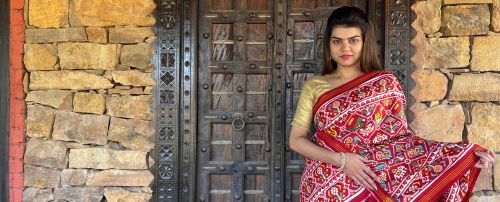Process of making Patola
01. Patan Patola
⇒ Warp and weft silk threads are tied separately with cotton thread on the portions already marked out in conformity with the proposed design in the fabric. This tied portion is meant to remain unexposed to the colour while dyeing. United portion which has absorbed one colour, may be tied while dyeing in another colour. Tyeing untying, retying and dyeing in different shades are the main features of this process.
⇒ After completion of dyeing work of warps & wefts, the threads of the warp of different repeats of a pattern are put together in a sequence on the loom, so that the design becomes visible. The threads of wefts are wound on to bobbins and kept in the bamboo shuttle for weaving process.
∗ Dyeing Process
01. Rajkot Patola
∗ Step 1 : Design
∗ Step 2 : Dyeing

